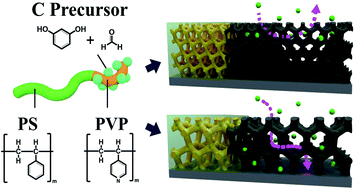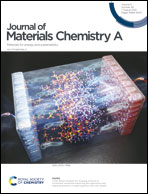High-performance ultracapacitor electrodes realized by 3-dimensionally bicontinuous block copolymer nanostructures with enhanced ion kinetics†
Abstract
Despite the high power density of ultracapacitors, increasing the energy density to level that of conventional battery systems remains a critical challenge. Here, we report the excellent electrochemical performance of three-dimensionally (3D) bicontinuous nanostructures with highly controlled, interconnected channels, which are derived from a self-assembled block copolymer as a well-defined and size-tunable framework. In contrast to previous reports, the 3D carbon electrodes with larger building block dimensions exhibited superior performances despite their smaller specific surface area. Electrochemical analyses reveal that these unusual phenomena are due to their markedly enhanced electrolyte accessibility, ion diffusion, and electrical conductivity. Consequently, excellent electrochemical properties are obtained, with the highest gravimetric capacitance of 507.3 F g−1, area-normalized capacitance of 88.8 μF cm−2, and cycling stability with over 98% capacitance retention after 30 000 cycles, achieving an outstanding energy density of 45.8 W h kg−1, which is even comparable to the values of rechargeable batteries.



 Please wait while we load your content...
Please wait while we load your content...